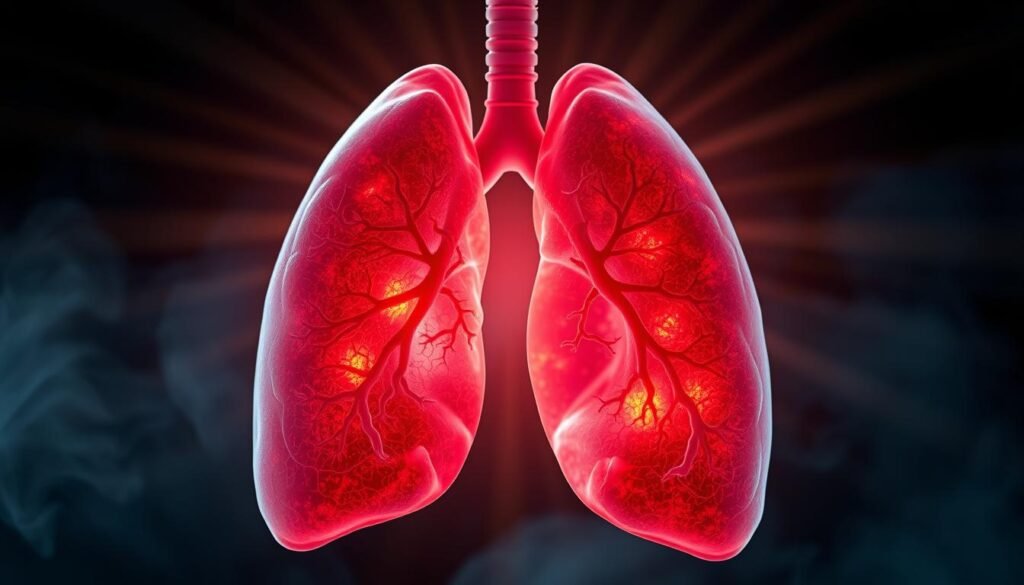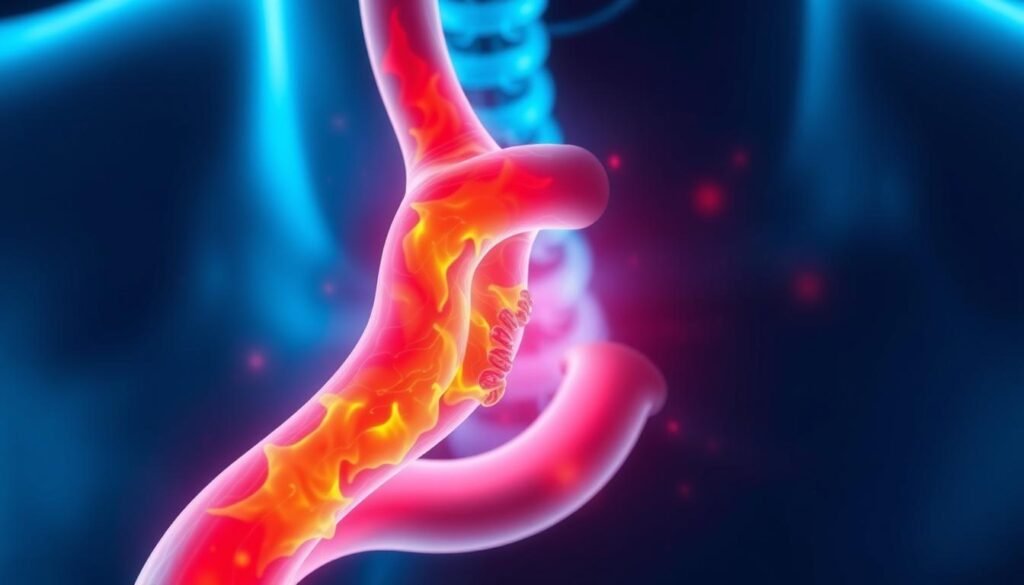Did you know that nearly 75% of patients see side effects in the first weeks of lung cancer radiation therapy? These effects can greatly vary and may cause discomfort. It is key for patients to understand what they might face.
Things like fatigue, nausea, and shortness of breath are common. These issues affect daily life for many. Knowing about them allows patients to seek support and keep their quality of life during aggressive lung cancer treatment.
Key Takeaways
- Side effects from radiation therapy often begin by the second or third week and can last weeks post-treatment.
- Common side effects include fatigue, nausea, and shortness of breath, among others.
- Most side effects generally resolve within 1–2 months after finishing radiation therapy.
- Fatigue is a prevalent issue for many individuals receiving treatment.
- Changes in appetite and eating habits are common and should be managed to maintain strength.
- Awareness of potential long-term effects is vital for proactive health management.
Understanding Lung Cancer Radiation Therapy
Lung cancer radiation therapy is crucial in treating many patients. It uses high-energy X-rays to target cancer cells, aiming to shrink tumors and kill cancerous tissues. This therapy helps relieve symptoms and can be given externally or internally.
External Beam Radiation Therapy (EBRT) is usually given five days a week for five to seven weeks. Sometimes, treatments are shorter, especially for palliative care. Stereotactic Body Radiation Therapy (SBRT) is quicker, lasting only seven to ten days, making it efficient.
Combining radiation with chemotherapy, or chemoradiation, improves outcomes. They’re often done at the same time. Planning treatment involves looking at tumor size, location, patient health, and the radiation type needed.
Correct dosage and precise targeting are key in treatment planning. This minimizes harm to healthy cells while hitting cancer cells hard. Managing side effects like fatigue, nausea, and skin problems is critical. These effects are often manageable with care and medication.
Thoracic radiation is becoming a key part of lung cancer treatment. Knowing about radiation helps patients and families make smart choices about treatment.
| Type of Radiation Therapy | Duration | Usage Context |
|---|---|---|
| External Beam Radiation Therapy (EBRT) | 5 days/week for 5-7 weeks | Main treatment or palliative |
| Stereotactic Body Radiation Therapy (SBRT) | 7-10 days | Focused treatment for specific tumors |
| Brachytherapy | Varies | Symptomatic relief |
| Chemoradiation | Concurrent with chemotherapy | Enhance treatment effectiveness |
What Are Lung Cancer Radiation Side Effects?
Radiation therapy is often used to fight lung cancer. It’s especially common for treating non-small cell lung cancer (NSCLC). When undergoing treatment, various radiation side effects may appear. These depend on the area treated, the cancer type, and the patient’s health.
Radiation therapy can last 5 to 7 weeks, with treatments five days a week. This process can bring about both immediate and lasting effects. Early symptoms include nausea, fatigue, and skin texture changes. Combining radiation with chemotherapy might make these effects more severe.
Soon after treatment starts, patients may face difficulty swallowing, skin issues, and breathlessness. Knowing these effects are normal can help patients be better prepared. For ways to handle these side effects, the Cancer Research UK website is a helpful resource.
Over time, more serious side effects can develop, such as lung damage. This can cause ongoing breathlessness and coughing. It’s vital for patients to talk openly with their doctors about any new or worrisome symptoms. This communication helps manage symptoms and increases the therapy’s success.

Common Early Side Effects of Radiation Therapy
During lung cancer radiation therapy, many patients face early side effects. Fatigue and skin changes are especially common. These can be uncomfortable but are generally manageable with the right care and advice.
Fatigue as a Common Reaction
Fatigue is a widespread early side effect of radiation therapy. As treatment goes on, patients often find themselves extremely tired, making daily tasks hard. Rest doesn’t always help, as this tiredness can stay for the whole treatment period. It’s important for both patients and caregivers to know about this side effect.
Skin Changes in the Treatment Area
Skin irritation is also a typical early side effect. Patients might see signs like redness, swelling, blistering, or sensitivity in the treated area. Taking care of your skin during this time is crucial. This helps manage irritation and prevents symptoms from getting worse. To help, you should:
- Avoid tight clothing that can rub against the skin.
- Use gentle, fragrance-free skin products to reduce irritation.
- Keep the treatment area clean and moisturized to aid recovery.
Most skin changes from radiation are temporary and improve after treatment ends. Talking openly with healthcare providers is key for dealing with these early side effects effectively.
| Early Side Effect | Description | Management |
|---|---|---|
| Fatigue | Overwhelming tiredness that worsens as treatment progresses. | Regular rest, gentle exercise, and consultation with a healthcare provider. |
| Skin Irritation | Redness, swelling, and sensitivity in the treated area. | Gentle skin care products, loose clothing, and keeping the area moisturized. |
| Radiation Dermatitis | Severe skin reaction leading to blistering and discomfort. | Medical creams, avoiding irritants, and following care instructions from medical professionals. |
Nausea and Appetite Loss
Many people getting radiation therapy for lung cancer face nausea and appetite loss. These issues cut down their desire to eat. It makes it hard to get the right nutrition needed for healing. Nausea management is key to keeping a healthy diet during this time.

Managing Nausea During Treatment
To tackle nausea and lost appetite, a few steps can help. One way is to change what you eat. Choose simple foods that won’t upset your stomach. These can be:
- Mashed potatoes
- Rice
- Bananas
- Applesauce
- Plain toast
Doctors often suggest anti-nausea medication too. These meds help make treatment more bearable. They let patients keep up their food intake.
Working with a dietitian is also helpful. This dietitian support is crucial. A dietitian can set up a meal plan just for you. They ensure you get the nutrients you need, even with appetite loss. Their help is big in avoiding malnutrition during treatment.
Using these methods helps patients feel better. It makes going through radiation for lung cancer easier.
Difficulty Swallowing and Esophageal Irritation
Radiation therapy for lung cancer can cause significant discomfort. This is often due to esophageal irritation. Known as radiation-induced esophagitis, this condition inflames the esophagus. This makes swallowing food painful and difficult. Reports show that 13% to 28% of patients experience this problem, depending on how it’s assessed.

Several factors raise the risk of severe irritation. Age and general health play a big part. For instance, people over 70 or those in poor health face worse symptoms. Also, higher doses of radiation can make swallowing more difficult.
To help with these issues, patients can try different dietary approaches. Eating soft foods like pudding and yogurt helps. It’s also good to cut food into small pieces and use sauces or gravies. Avoiding hard, spicy food, along with alcohol and tobacco, reduces throat irritation.
Staying hydrated is key to managing side effects from radiation. Patients should drink six to eight glasses of water daily unless advised otherwise. Throat sprays and lozenges can also ease pain, especially if used before meals. For those losing weight because of these problems, it’s vital to talk to a doctor about nutritional supplements. With the right care, patients can find relief from esophageal irritation.
Seeking more information is always helpful. For deeper understanding, visiting resources on radiation-induced complications and nutrition is a good idea. Knowing more about radiation therapy helps patients manage their treatment better.
Shortness of Breath and Coughing
Patients treating lung cancer with radiation often face tough issues. These include shortness of breath and coughing. Over time, these problems may get worse. And they could linger long after treatment ends.
About 54% of patients feel short of breath within six months of Stereotactic Body Radiation Therapy (SBRT). In 25 cases, the issue was severe. Knowing how to handle these symptoms is key.
Understanding Causes and Management
Coughing might get worse with radiation sessions. A lasting cough or breathlessness can point to radiation pneumonitis. This serious issue can pop up weeks or months after treatment.
It shows up as a continuing cough, trouble breathing, slight fever, and chest congestion. Managing these issues properly is very important.
Here are tips to ease these symptoms:
- Breathing exercises: These can boost lung power and make breathing easier.
- Consulting healthcare providers: Talking about worse symptoms helps. Doctors can then make care better.
- Medications: Drugs like bronchodilators and cough suppressants can help with the cough.
- Oxygen therapy: For tough breathlessness, extra oxygen can help right away.
Stay alert for any new or worse symptoms after radiation. Your healthcare team can offer special plans and treatments for these issues.
Potential Long-Term Side Effects
Radiation therapy can cause several long-term side effects. These may not show up for months or years after treatment. Although rare, they can greatly affect a patient’s health and quality of life. It’s key for those treated for lung cancer or nearby areas to know about these risks.
Lung Complications and Permanent Damage
About one in four lung cancer patients might face lung complications. Radiation pneumonitis is one such condition. It leads to lung tissue inflammation. That can cause a chronic cough, breathing trouble, and discomfort.
Over time, these issues may turn into pulmonary fibrosis. This condition lowers lung capacity and respiratory function.
Heart Complications Following Treatment
Radiation therapy can also lead to heart complications. This is more likely if the chest area was treated. The risk for heart diseases, like heart attacks and failure, goes up. Regular checks and care can help keep the heart healthy after treatment.
| Type of Complication | Possible Symptoms | Long-Term Effects |
|---|---|---|
| Lung Complications | Chronic cough, difficulty breathing | Pulmonary fibrosis, reduced lung capacity |
| Heart Complications | Chest pain, fatigue, palpitations | Increased risk of cardiovascular disease |
Talking and staying updated with healthcare providers is important. Patients should keep an eye on symptoms. This way, they can catch and manage any long-term side effects early.
The Influence of Chemotherapy on Side Effects
Chemotherapy is a key player in lung cancer treatment. It aims to shrink tumors and attack remaining cancer cells. Combined treatment with radiation therapy, though, can make side effects worse. Patients often feel more tired, sick, and generally unwell, showing the importance of knowing what to expect.
About 80% of people getting chemotherapy face nausea and vomiting due to treatment, adding to the radiation therapy side effects. Fatigue is also common, impacting energy and life quality. Talking regularly with healthcare providers is key to handle these issues.
Healthcare teams have strategies to lessen these symptoms, tailored to each person. This includes managing problems like constipation or numbness in hands and feet. It’s important to talk about side effects early on. For more tips on dealing with treatment issues, Cancer Research UK is a helpful resource for patients and caretakers.